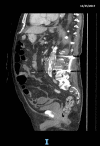Bleeding "sarcomatosis" as a rare presentation of vascular graft-related angiosarcoma: case report and review of the literature
- PMID: 33218319
- PMCID: PMC7678180
- DOI: 10.1186/s12893-020-00966-7
Bleeding "sarcomatosis" as a rare presentation of vascular graft-related angiosarcoma: case report and review of the literature
Abstract
Background: Angiosarcoma is a rare malignant tumor, originating from vascular endothelial cells, accounting for approximatively 1-2% of soft tissue sarcomas. It is characterized by a rapid proliferation and high metastatic potential. Some cases of angiosarcoma are described in association with vascular prosthesis, orthopedic devices and foreign bodies. Hereby, we report a case of a patient treated with the endovascular placement of a PTFE aorto bis-iliac prosthesis for aortic aneurysm, who developed a graft-related angiosarcoma with bone and peritoneal localizations. The peritoneal "sarcomatosis" led to an acute presentation with hemoperitoneum and anemia. We perform a thorough review of the literature summarizing the description of similar cases, their epidemiology and the possibilities for treatment.
Case presentation: An 84-year-old male with a history of abdominal aortic aneurysm endovascular repair presented to our emergency department complaining with low back pain radiating to the left limb. He underwent a type II endoleak embolization of the aneurysmal sac nine days before. During hospitalization he underwent a spine MRI which documented a vertebral alteration of non-univocal interpretation. Vertebral biopsy was performed revealing groups of cells of uncertain nature. He lately underwent percutaneous L2-L4 arthrodesis. Forty-two days after admission, he developed acute anemia. Emergency laparotomy revealed a massive hemoperitoneum and actively bleeding peritoneal nodules. Abdominal packing was performed, and several nodules were sent for definitive histological examination. After surgery, he developed progressive and severe hypovolemic shock and expired on postoperative day 5.
Conclusions: Angiosarcoma associated with foreign bodies, especially vascular prosthesis, is a very rare entity. In patients who have a history of prosthetic vascular graft placement that present with lumbar pain, osteolytic changes at radiologic imaging or the development of ascites, angiosarcoma should be considered in the differential diagnosis. Despite the poor prognosis, a prompt diagnosis might give access to an adequate treatment planning, with the aim for disease control and increased survival.
Keywords: Angiosarcoma; Case report; Sarcomatosis; Vascular-graft.
Conflict of interest statement
The authors declare that they have no competing interests.
Figures






Similar articles
-
Angiosarcoma after endovascular aneurysm repair: case report and literature review.Acta Chir Belg. 2023 Jun;123(3):317-324. doi: 10.1080/00015458.2021.2021718. Epub 2022 Jan 19. Acta Chir Belg. 2023. PMID: 34937527 Review.
-
Treatment of sac expansion after endovascular aneurysm repair with obliterating endoaneurysmorrhaphy and stent graft preservation.J Vasc Surg. 2016 Apr;63(4):902-8. doi: 10.1016/j.jvs.2015.10.059. Epub 2015 Nov 21. J Vasc Surg. 2016. PMID: 26610645
-
Aortic Epithelioid Angiosarcoma after Endovascular Aneurysm Repair.Ann Vasc Surg. 2016 Aug;35:207.e17-21. doi: 10.1016/j.avsg.2016.02.014. Epub 2016 May 27. Ann Vasc Surg. 2016. PMID: 27238982
-
Aortic Angiosarcoma in Association with Endovascular Aneurysm Repair: Case Report and Review of the Literature.Am J Case Rep. 2021 Jun 12;22:e931740. doi: 10.12659/AJCR.931740. Am J Case Rep. 2021. PMID: 34118148 Free PMC article. Review.
-
Predisposing Factors for Migration of the Iliac Limb and Reintervention after Endovascular Abdominal Aortic Aneurysm Repair.Ann Vasc Surg. 2019 Aug;59:91-101. doi: 10.1016/j.avsg.2019.01.007. Epub 2019 Apr 19. Ann Vasc Surg. 2019. PMID: 31009727
Cited by
-
Development of an Undifferentiated Pleomorphic Sarcoma After Aortic Aneurysm Graft Replacement: A Case Report and Literature Review.Cureus. 2024 Jun 2;16(6):e61530. doi: 10.7759/cureus.61530. eCollection 2024 Jun. Cureus. 2024. PMID: 38827416 Free PMC article.
-
Etiology, pathogenesis, and management of angiosarcoma associated with implants and foreign body: Clinical cases and research updates.Medicine (Baltimore). 2024 May 3;103(18):e37932. doi: 10.1097/MD.0000000000037932. Medicine (Baltimore). 2024. PMID: 38701315 Free PMC article. Review.
-
Ibero-American Consensus for the Management of Peritoneal Sarcomatosis: Updated Review and Clinical Recommendations.Cancers (Basel). 2024 Jul 25;16(15):2646. doi: 10.3390/cancers16152646. Cancers (Basel). 2024. PMID: 39123374 Free PMC article. Review.
-
Rapid Progression of Angiosarcoma in a Man with a Left Psoas Muscle Hematoma and a Recent EVAR of Abdominal Aorta.Maedica (Bucur). 2023 Sep;18(3):519-522. doi: 10.26574/maedica.2023.18.3.519. Maedica (Bucur). 2023. PMID: 38023756 Free PMC article.
-
Angiosarcoma of the abdominal aorta after previous endovascular aneurysm repair.J Vasc Surg Cases Innov Tech. 2025 Jun 13;11(5):101878. doi: 10.1016/j.jvscit.2025.101878. eCollection 2025 Oct. J Vasc Surg Cases Innov Tech. 2025. PMID: 40735170 Free PMC article.
References
-
- Young RJ, Brown NJ, Reed MW, Hughes D, Woll PJ. Angiosarcoma. Lancet Oncol. 2010;11(10):983–991. - PubMed
-
- Lahat G, Dhuka AR, Hallevi H, Xiao L, Zou C, Smith KD, Phung TL, Pollock RE, Benjamin R, Hunt KK, Lazar AJ, Lev D. Angiosarcoma: clinical and molecular insights. Ann Surg. 2010;251(6):1098–1106. - PubMed
-
- Huntington JT, Jones C, Liebner DA, Chen JL, Pollock RE. Angiosarcoma: a rare malignancy with protean clinical presentations. J Surg Oncol. 2015;111(8):941–950. - PubMed
-
- Allison KH, Yoder BJ, Bronner MP, Goldblum JR, Rubin BP. Angiosarcoma involving the gastrointestinal tract: a series of primary and metastatic cases. Am J Surg Pathol. 2004;28(3):298–307. - PubMed
-
- Agaimy A, Ben-Izhak O, Lorey T, Scharpf M, Rubin BP. Angiosarcoma arising in association with vascular Dacron grafts and orthopedic joint prostheses: clinicopathologic, immunohistochemical, and molecular study. Ann Diagn Pathol. 2016;21:21–28. - PubMed
Publication types
MeSH terms
LinkOut - more resources
Full Text Sources
Miscellaneous

